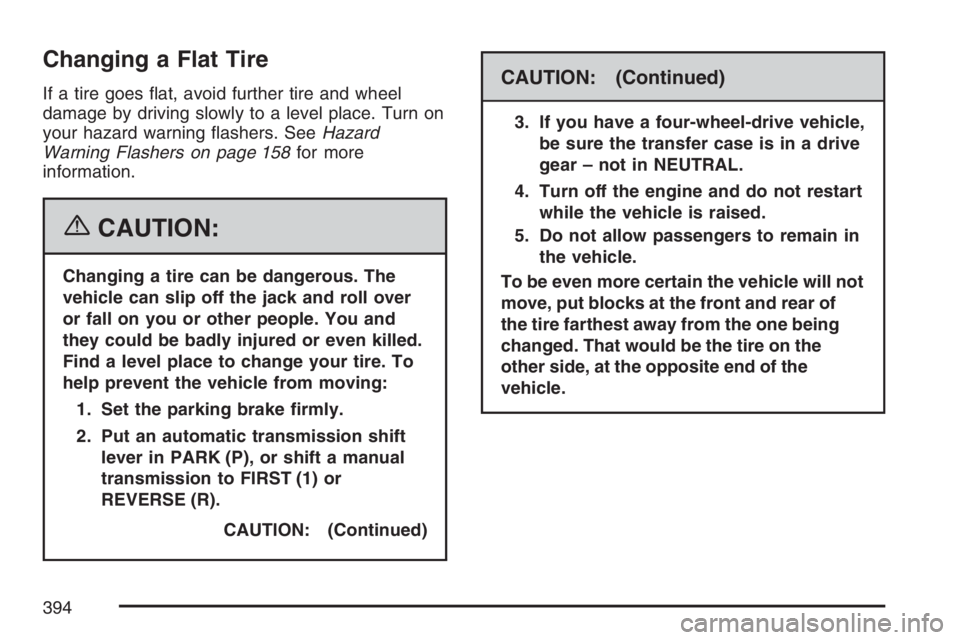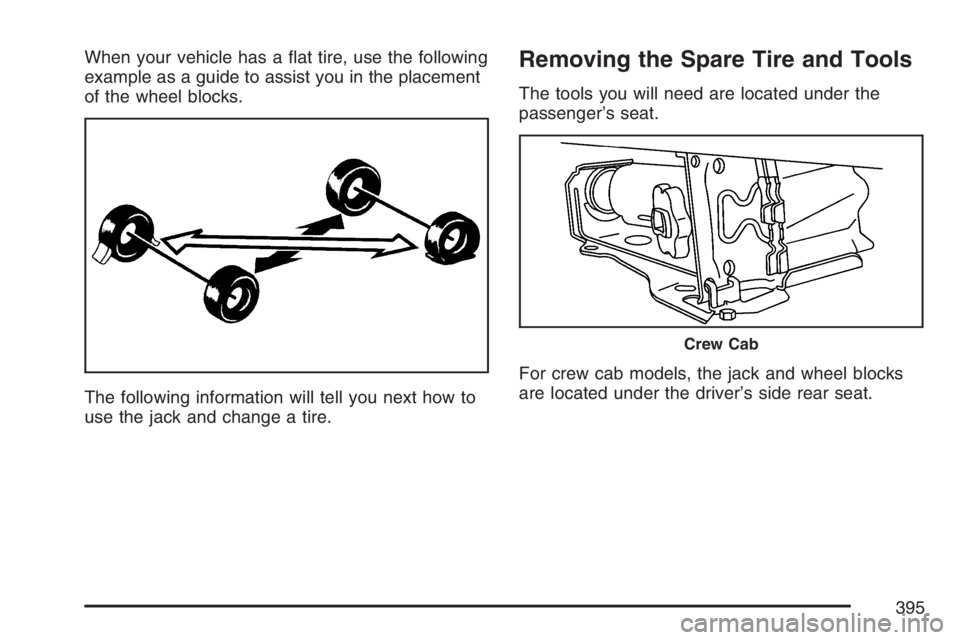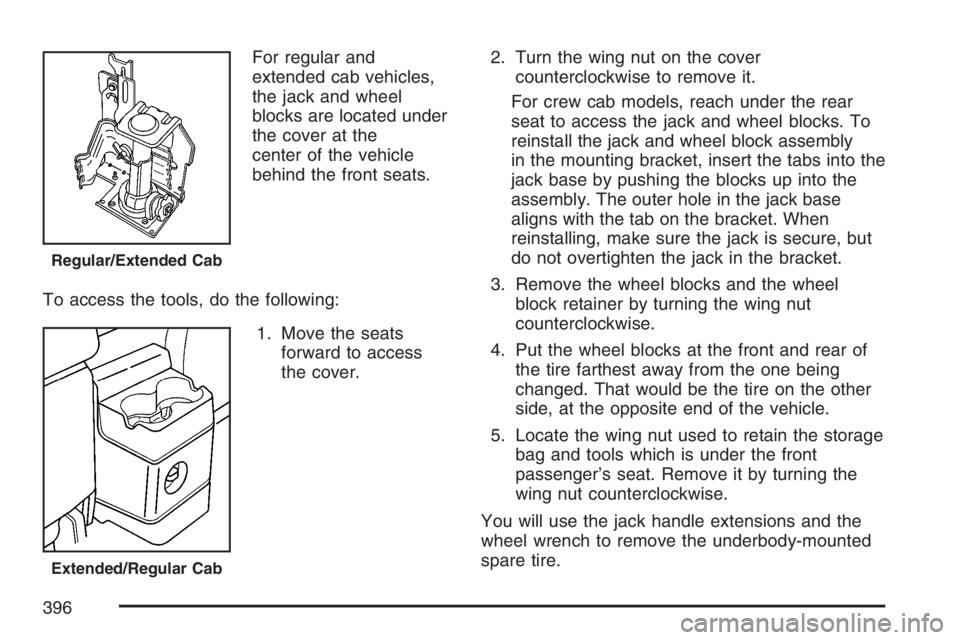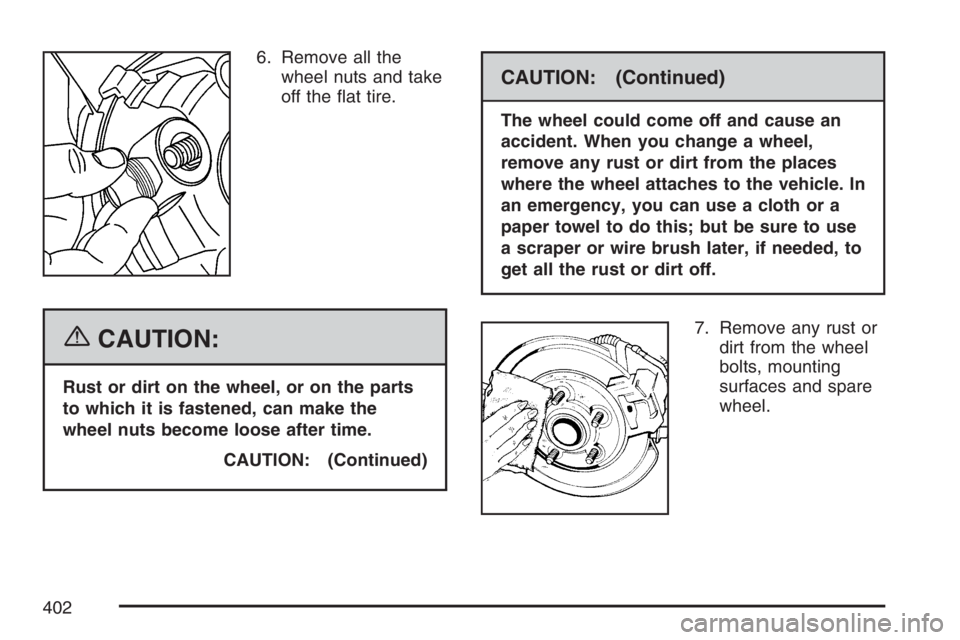2007 GMC CANYON change wheel
[x] Cancel search: change wheelPage 383 of 492

Federal Communications Commission
(FCC) and Industry and Science Canada
The Tire Pressure Monitor System (TPMS)
operates on a radio frequency and complies with
Part 15 of the FCC Rules. Operation is subject
to the following two conditions:
1. This device may not cause harmful
interference.
2. This device must accept any interference
received, including interference that may
cause undesired operation.
The Tire Pressure Monitor System (TPMS)
operates on a radio frequency and complies with
RSS-210 of Industry and Science Canada.
Operation is subject to the following two
conditions:
1. This device may not cause interference.
2. This device must accept any interference
received, including interference that may
cause undesired operation of the device.
Changes or modi�cations to this system by other
than an authorized service facility could void
authorization to use this equipment.
Tire Inspection and Rotation
Tires should be rotated every 5,000 to 8,000 miles
(8 000 to 13 000 km).
Any time you notice unusual wear, rotate your
tires as soon as possible and check wheel
alignment. Also check for damaged tires or wheels.
SeeWhen It Is Time for New Tires on page 385
andWheel Replacement on page 390for
more information.
Make sure the spare tire is stored securely. Push,
pull, and then try to rotate or turn the tire. If it
moves, use the wheel wrench to tighten the cable.
SeeChanging a Flat Tire on page 394.
The purpose of regular rotation is to achieve more
uniform wear for all tires on the vehicle. The
�rst rotation is the most important, seeScheduled
Maintenance on page 437.
383
Page 384 of 492

When rotating your tires, always use one of the
correct rotation patterns shown here.
If your vehicle has a compact spare tire or a spare
tire that does not match your vehicle’s road tires
and wheels, in size and type, do not include
the spare in the tire rotation.
After the tires have been rotated, adjust the front
and rear in�ation pressures as shown on the
Tire and Loading Information label. For the location
of the Tire and Loading Information label see
Loading Your Vehicle on page 286. Make certain
that all wheel nuts are properly tightened, see
“Wheel Nut Torque” underCapacities and
Speci�cations on page 430for the proper wheel
nut torque speci�cation.
{CAUTION:
Rust or dirt on a wheel, or on the parts to
which it is fastened, can make wheel nuts
become loose after time. The wheel could
come off and cause an accident. When
you change a wheel, remove any rust or
dirt from places where the wheel attaches
to the vehicle. In an emergency, you can
use a cloth or a paper towel to do this;
but be sure to use a scraper or wire brush
later, if needed, to get all the rust or dirt
off. SeeChanging a Flat Tire on page 394.
Any time you rotate the vehicle’s tires the Tire
Pressure Monitor System (TPMS) will need to be
reset. The TPMS identi�cation codes will need
to be matched to the tire and wheel position. See
“TPMS Sensor Identi�cation Codes” underTire
Pressure Monitor System on page 378.
384
Page 393 of 492

If a Tire Goes Flat
It is unusual for a tire to blowout while you are
driving, especially if you maintain your vehicle’s
tires properly. If air goes out of a tire, it is
much more likely to leak out slowly. But if you
should ever have a blowout, here are a few tips
about what to expect and what to do:
If a front tire fails, the �at tire will create a drag
that pulls the vehicle toward that side. Take your
foot off the accelerator pedal and grip the
steering wheel �rmly. Steer to maintain lane
position, and then gently brake to a stop well out
of the traffic lane.
A rear blowout, particularly on a curve, acts much
like a skid and may require the same correction
you would use in a skid. In any rear blowout
remove your foot from the accelerator pedal. Get
the vehicle under control by steering the way
you want the vehicle to go. It may be very bumpy
and noisy, but you can still steer. Gently brake
to a stop, well off the road if possible.{CAUTION:
Lifting a vehicle and getting under it to do
maintenance or repairs is dangerous
without the appropriate safety equipment
and training. The jack provided with your
vehicle is designed only for changing a �at
tire. If it is used for anything else, you or
others could be badly injured or killed if the
vehicle slips off the jack. Use the jack
provided with your vehicle only for
changing a �at tire.
If a tire goes �at, the next part shows how to use the
jacking equipment to change a �at tire safely.
393
Page 394 of 492

Changing a Flat Tire
If a tire goes �at, avoid further tire and wheel
damage by driving slowly to a level place. Turn on
your hazard warning �ashers. SeeHazard
Warning Flashers on page 158for more
information.
{CAUTION:
Changing a tire can be dangerous. The
vehicle can slip off the jack and roll over
or fall on you or other people. You and
they could be badly injured or even killed.
Find a level place to change your tire. To
help prevent the vehicle from moving:
1. Set the parking brake �rmly.
2. Put an automatic transmission shift
lever in PARK (P), or shift a manual
transmission to FIRST (1) or
REVERSE (R).
CAUTION: (Continued)
CAUTION: (Continued)
3. If you have a four-wheel-drive vehicle,
be sure the transfer case is in a drive
gear – not in NEUTRAL.
4. Turn off the engine and do not restart
while the vehicle is raised.
5. Do not allow passengers to remain in
the vehicle.
To be even more certain the vehicle will not
move, put blocks at the front and rear of
the tire farthest away from the one being
changed. That would be the tire on the
other side, at the opposite end of the
vehicle.
394
Page 395 of 492

When your vehicle has a �at tire, use the following
example as a guide to assist you in the placement
of the wheel blocks.
The following information will tell you next how to
use the jack and change a tire.Removing the Spare Tire and Tools
The tools you will need are located under the
passenger’s seat.
For crew cab models, the jack and wheel blocks
are located under the driver’s side rear seat.
Crew Cab
395
Page 396 of 492

For regular and
extended cab vehicles,
the jack and wheel
blocks are located under
the cover at the
center of the vehicle
behind the front seats.
To access the tools, do the following:
1. Move the seats
forward to access
the cover.2. Turn the wing nut on the cover
counterclockwise to remove it.
For crew cab models, reach under the rear
seat to access the jack and wheel blocks. To
reinstall the jack and wheel block assembly
in the mounting bracket, insert the tabs into the
jack base by pushing the blocks up into the
assembly. The outer hole in the jack base
aligns with the tab on the bracket. When
reinstalling, make sure the jack is secure, but
do not overtighten the jack in the bracket.
3. Remove the wheel blocks and the wheel
block retainer by turning the wing nut
counterclockwise.
4. Put the wheel blocks at the front and rear of
the tire farthest away from the one being
changed. That would be the tire on the other
side, at the opposite end of the vehicle.
5. Locate the wing nut used to retain the storage
bag and tools which is under the front
passenger’s seat. Remove it by turning the
wing nut counterclockwise.
You will use the jack handle extensions and the
wheel wrench to remove the underbody-mounted
spare tire.
Regular/Extended Cab
Extended/Regular Cab
396
Page 402 of 492

6. Remove all the
wheel nuts and take
off the �at tire.
{CAUTION:
Rust or dirt on the wheel, or on the parts
to which it is fastened, can make the
wheel nuts become loose after time.
CAUTION: (Continued)
CAUTION: (Continued)
The wheel could come off and cause an
accident. When you change a wheel,
remove any rust or dirt from the places
where the wheel attaches to the vehicle. In
an emergency, you can use a cloth or a
paper towel to do this; but be sure to use
a scraper or wire brush later, if needed, to
get all the rust or dirt off.
7. Remove any rust or
dirt from the wheel
bolts, mounting
surfaces and spare
wheel.
402
Page 491 of 492

Tires (cont.)
Tire Sidewall Labeling.............................. 370
Tire Terminology and De�nitions............... 374
Uniform Tire Quality Grading.................... 389
Wheel Alignment and Tire Balance........... 390
Wheel Replacement................................. 390
When It Is Time for New Tires................. 385
Towing
Recreational Vehicle................................. 293
Towing a Trailer....................................... 300
Your Vehicle............................................. 292
Traction
Control System (TCS).............................. 249
Limited-Slip Rear Axle.............................. 250
Trailer
Recommendations.................................... 311
Transmission
Fluid, Automatic....................................... 331
Fluid, Manual........................................... 334
Up-Shift Light........................................... 185
Transmission Operation, Automatic.............. 120
Transmission Operation, Manual.................. 124
Trip Odometer............................................. 179
Truck-Camper Loading Information.............. 292Turn and Lane-Change Signals................... 160
Turn Signal/Multifunction Lever.................... 159
U
Understanding Radio Reception................... 238
Uniform Tire Quality Grading....................... 389
Up-Shift Light.............................................. 185
V
Vehicle
Control..................................................... 246
Damage Warnings....................................... 5
Loading.................................................... 286
Parking Your............................................ 134
Symbols...................................................... 5
Vehicle Data Collection and Event Data
Recorders................................................ 468
Vehicle Identi�cation
Number (VIN).......................................... 424
Service Parts Identi�cation Label.............. 425
Ventilation Adjustment.................................. 176
Visors.......................................................... 112
491